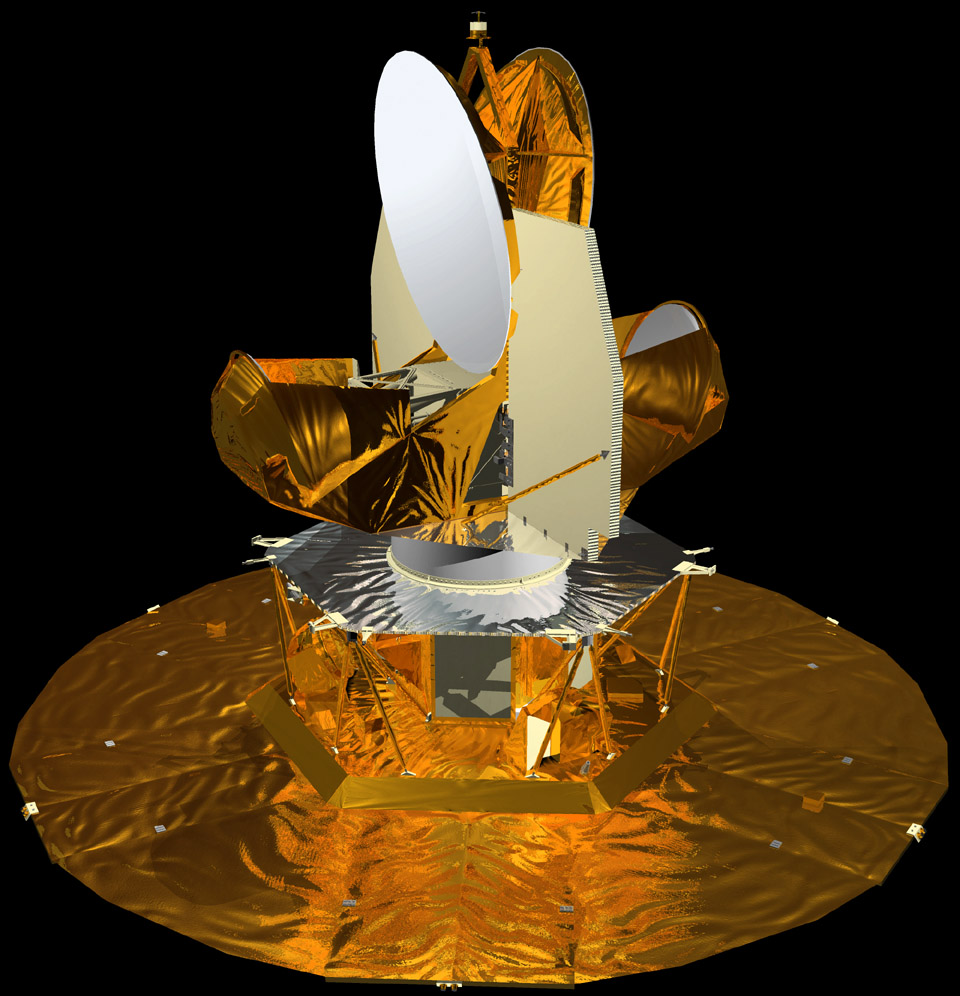



As a brief introduction to ASTR 452, to supplement the Course Description, here we survey the course, which provides a glimpse of our distant cosmos, and highlights some of the exotic and fascinating objects, structures and phenomena that are found in the greater Universe. This gallery is a representative (but of course incomplete) sampling of the material covered in the course.
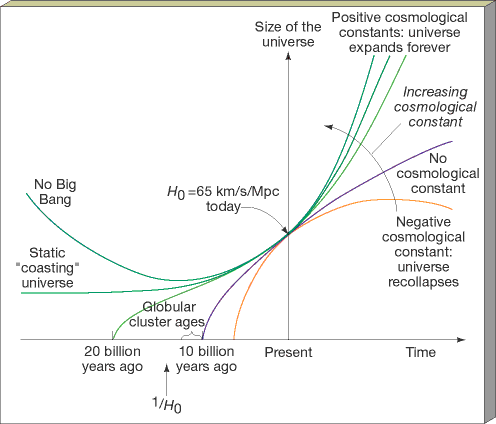 The cosmology sector of the course begins with a discussion of the
cosmological principle, the fundamental axiom that underpins the global
structure of the universe. Then it moves to cosmochronology, the dating
of distant objects and epochs in the universe. As a prelude to the
fuller discussion of the spacetime of the universe, Newtonian cosmology
is studied now, defining the essential structure of the expansion of the
universe subsequent to the Big Bang, without being encumbered by the
mathematical formalism associated with general relativity. This weak
field limit suffices to identify key elements of a matter-dominated
universe such as the critical closure density, which demarcates criteria
for open and closed universes.
On the left is a schematic for the array of cosmological
possibilities for the evolution and fate of the universe. The present
age of the universe and the acceleration/deceleration of the expansion
depend on the values of the matter density and the cosmological
constant. (From Astronomy Today, by Chaisson & McMillan).
The cosmology sector of the course begins with a discussion of the
cosmological principle, the fundamental axiom that underpins the global
structure of the universe. Then it moves to cosmochronology, the dating
of distant objects and epochs in the universe. As a prelude to the
fuller discussion of the spacetime of the universe, Newtonian cosmology
is studied now, defining the essential structure of the expansion of the
universe subsequent to the Big Bang, without being encumbered by the
mathematical formalism associated with general relativity. This weak
field limit suffices to identify key elements of a matter-dominated
universe such as the critical closure density, which demarcates criteria
for open and closed universes.
On the left is a schematic for the array of cosmological
possibilities for the evolution and fate of the universe. The present
age of the universe and the acceleration/deceleration of the expansion
depend on the values of the matter density and the cosmological
constant. (From Astronomy Today, by Chaisson & McMillan).
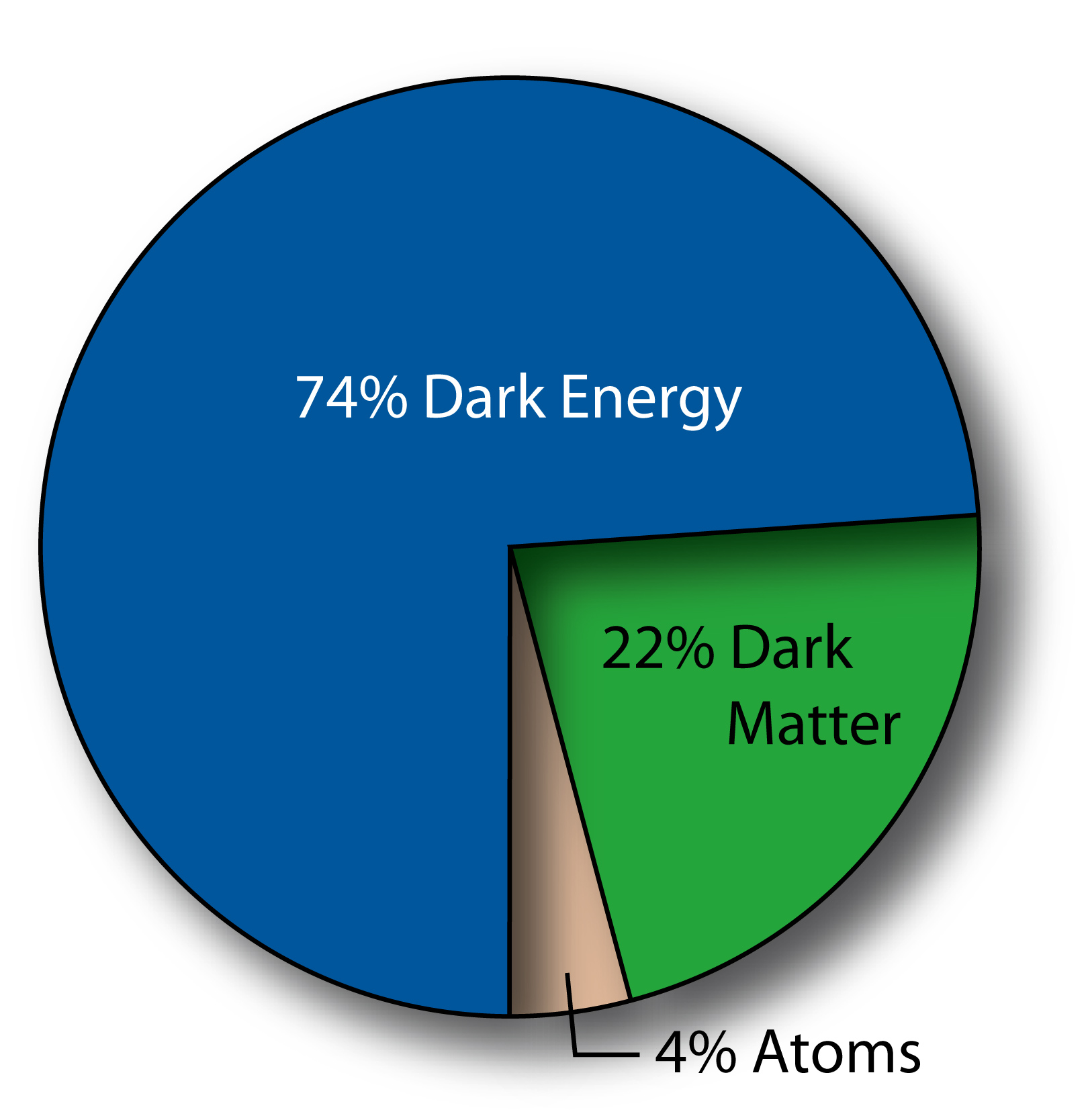 The fuller formalism of relativistic cosmology is now advanced,
prefaced by an entree of general relativity. This then introduces
the students to the Robertson-Walker metric, and the Friedman equation.
Solutions for both matter- and radiation-dominated universes are
explored to identify the concept of the Big Bang, which pre-dated the
discovery of the CMB by over 3 decades. Einstein's famous cosmological
constant is introduced, employed by him to explain the near-Euclidean
character of our space. Then we connect to the real universe by
expounding upon observables such as the lookback time, angular diameters
and inferred luminosities, as they appear to us, as functions of the
redshift to a source. This sets the scene for a study of supernova
cosmology at redshifts z~0.1-1, the first tool to determine that the
Hubble expansion is accelerating, thereby promoting the need for a
repulsive force on cosmological scales that has been annointed "Dark
Energy."
On the right is a pie chart for the current determination of
the make-up of the universe, based on supernova probes at moderate
redshifts and the power spectrum of fluctuations in the cosmic microwave
background radiation.
The fuller formalism of relativistic cosmology is now advanced,
prefaced by an entree of general relativity. This then introduces
the students to the Robertson-Walker metric, and the Friedman equation.
Solutions for both matter- and radiation-dominated universes are
explored to identify the concept of the Big Bang, which pre-dated the
discovery of the CMB by over 3 decades. Einstein's famous cosmological
constant is introduced, employed by him to explain the near-Euclidean
character of our space. Then we connect to the real universe by
expounding upon observables such as the lookback time, angular diameters
and inferred luminosities, as they appear to us, as functions of the
redshift to a source. This sets the scene for a study of supernova
cosmology at redshifts z~0.1-1, the first tool to determine that the
Hubble expansion is accelerating, thereby promoting the need for a
repulsive force on cosmological scales that has been annointed "Dark
Energy."
On the right is a pie chart for the current determination of
the make-up of the universe, based on supernova probes at moderate
redshifts and the power spectrum of fluctuations in the cosmic microwave
background radiation.
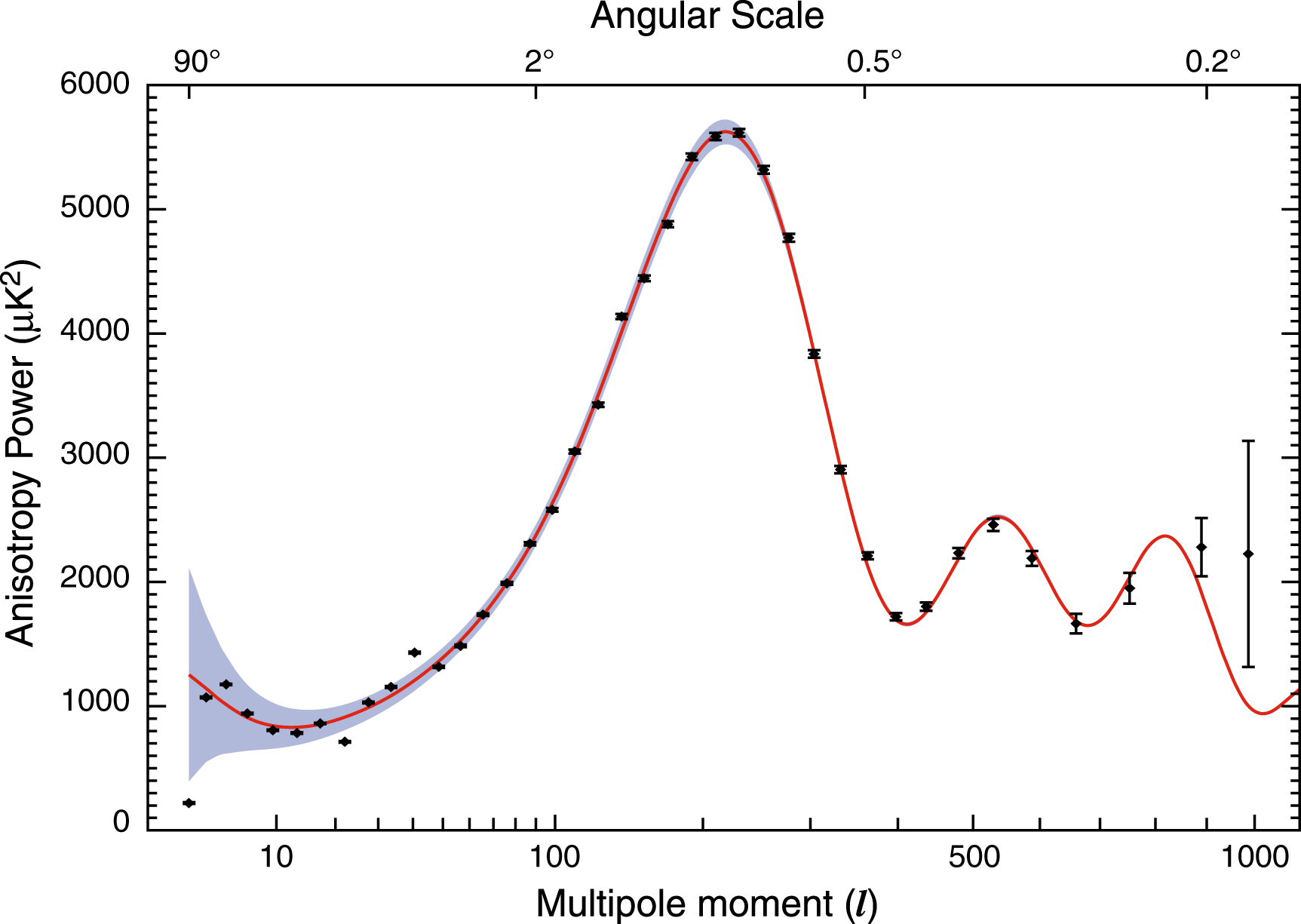 The smoking gun for evidence of the Big Bang is the cosmic microwave background
radiation (CMB), the relic of the early universe when the matter was
decoupling from light. This forms the next focus of the course,
starting with its discovery, determination of its blackbody form,
dipolar anisotropy as evidence of the peculiar motion of the solar
system, and the full-blown power spectrum of angular fluctuations as
determined recently by the WMAP experiment. Diagnostics using CMB
polarization measurements will be discussed. Its existence rules against
steady-state universes, and its dappled appearance in sky maps
(click here for the WMAP sky distribution) signals
the onset of structure formation in the universe. Accordingly, this
rich physical manifestation of the universe dating from over 13 billion
years ago has garnered two Nobel Prizes in physics.
The power-spectrum of angular fluctuations in the CMB, as measured recently by the
Wilkinson Microwave Anisotropy Probe (WMAP: see the
WMAP Media Outreach Page),
is depicted on the right.
The smoking gun for evidence of the Big Bang is the cosmic microwave background
radiation (CMB), the relic of the early universe when the matter was
decoupling from light. This forms the next focus of the course,
starting with its discovery, determination of its blackbody form,
dipolar anisotropy as evidence of the peculiar motion of the solar
system, and the full-blown power spectrum of angular fluctuations as
determined recently by the WMAP experiment. Diagnostics using CMB
polarization measurements will be discussed. Its existence rules against
steady-state universes, and its dappled appearance in sky maps
(click here for the WMAP sky distribution) signals
the onset of structure formation in the universe. Accordingly, this
rich physical manifestation of the universe dating from over 13 billion
years ago has garnered two Nobel Prizes in physics.
The power-spectrum of angular fluctuations in the CMB, as measured recently by the
Wilkinson Microwave Anisotropy Probe (WMAP: see the
WMAP Media Outreach Page),
is depicted on the right.
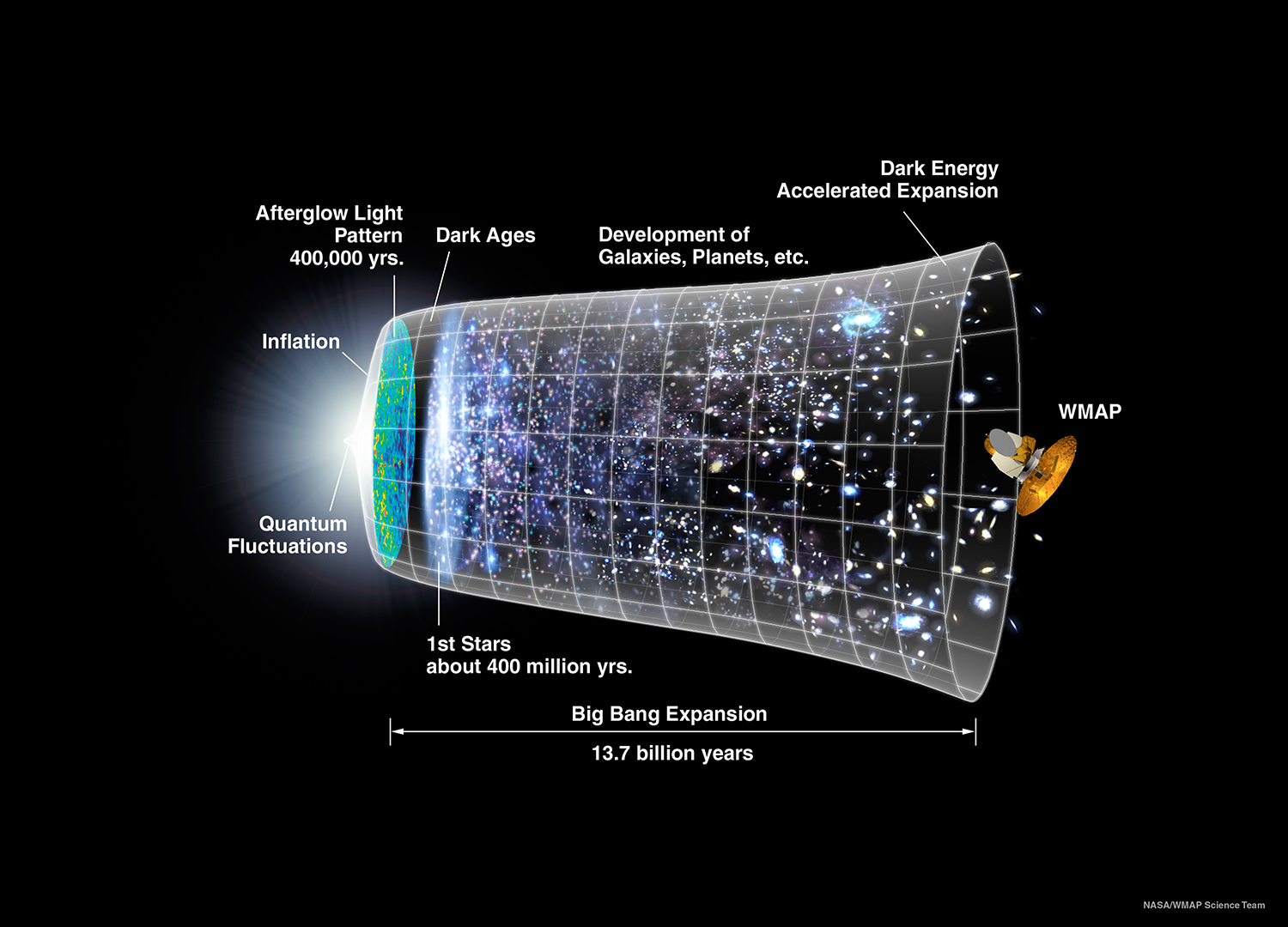 The final chapter in our cosmology saga concerns the history and
evolution of the universe. This focuses first on the thermal history
since the Big Bang, transitioning from the radiation-dominated to the
matter-dominated epoch. The first 3 minutes is not just a
catchphrase here, but defines the era when the nucleosynthetic status
quo was effectively established. The principal interactions in primordial
nucleosynthesis and the roles of deuterium and lithium in probing the
matter content of the universe are identified. The eras of
recombination and last scattering also form a focus, followed by a brief
foray into the gravitational perturbation physics of structure
formation. Finally, the course will venture into the exotic world of
inflation, the postulate for the rapid expansion of the quantum soup
that constituted the extremely early universe. This theory has recently
garnered excitement again with the topical evidence for propulsion of
the universe's expansion by a mysterious form of Dark Energy.
At right, a depiction of the evolution of the expanding universe,
highlighting the rampant "explosion" during the inflationary epoch, the
comparatively stable era of structure and galaxy formation up to the
present time, where acceleration of the expansion has now become
profound. From the
WMAP Media Outreach Page.
The final chapter in our cosmology saga concerns the history and
evolution of the universe. This focuses first on the thermal history
since the Big Bang, transitioning from the radiation-dominated to the
matter-dominated epoch. The first 3 minutes is not just a
catchphrase here, but defines the era when the nucleosynthetic status
quo was effectively established. The principal interactions in primordial
nucleosynthesis and the roles of deuterium and lithium in probing the
matter content of the universe are identified. The eras of
recombination and last scattering also form a focus, followed by a brief
foray into the gravitational perturbation physics of structure
formation. Finally, the course will venture into the exotic world of
inflation, the postulate for the rapid expansion of the quantum soup
that constituted the extremely early universe. This theory has recently
garnered excitement again with the topical evidence for propulsion of
the universe's expansion by a mysterious form of Dark Energy.
At right, a depiction of the evolution of the expanding universe,
highlighting the rampant "explosion" during the inflationary epoch, the
comparatively stable era of structure and galaxy formation up to the
present time, where acceleration of the expansion has now become
profound. From the
WMAP Media Outreach Page.
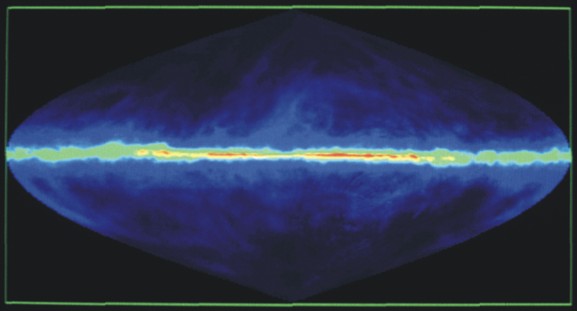 Having established the framework for the greater structure and evolution
of the Universe, we now turn to a guided tour of its more discrete entities,
and the development of our understanding of the extragalactic frontier.
The Universe is truly diverse in terms of its constituents, and our
closest host, the Milky Way galaxy, is a fascinating and fairly
representative place to start our exploration of the greater cosmos.
This portion of the course begins with a description of the morphology of the
Milky Way, namely the spatial distribution of constituent stars, gas and
dust, defining the disk, bulge and halo. The material will also touch
upon the Galactic fountain model, the Magellanic Stream, and the tool of
gravitational microlensing, all in relation to the halo.
On the left is the 21cm composite sky map from the NRAO Image Gallery, in galactic coordinates,
illustrating the distribution of neutral hydrogen in the Milky Way.
Having established the framework for the greater structure and evolution
of the Universe, we now turn to a guided tour of its more discrete entities,
and the development of our understanding of the extragalactic frontier.
The Universe is truly diverse in terms of its constituents, and our
closest host, the Milky Way galaxy, is a fascinating and fairly
representative place to start our exploration of the greater cosmos.
This portion of the course begins with a description of the morphology of the
Milky Way, namely the spatial distribution of constituent stars, gas and
dust, defining the disk, bulge and halo. The material will also touch
upon the Galactic fountain model, the Magellanic Stream, and the tool of
gravitational microlensing, all in relation to the halo.
On the left is the 21cm composite sky map from the NRAO Image Gallery, in galactic coordinates,
illustrating the distribution of neutral hydrogen in the Milky Way.
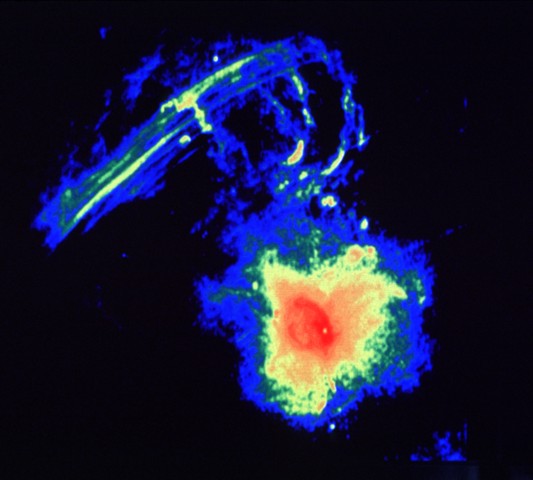 The kinematics of the Milky Way forms the next focus, covering how
peculiar velocities provide information concerning the global motion of
the Galaxy. We will discuss the Oort model of galactic rotation and in
particular how the rotation curve provides a profound indication for the
existence of dark matter. Then our attention will turn to the
fascinating Galactic Center region, a rich and dynamic environment that
is strongly influenced, if not powered, by the presence of a
supermassive black hole. Keplerian evidence for the existence and mass
estimation of this black hole will be presented, a technique widely employed
in various extragalactic contexts. The course will
describe molecular and radio structures near the Center, and touch upon
recent discoveries in the X-ray band.
At right is a 20cm Very Large Array (VLA) radio image (from the
NRAO Image Gallery)
of the Sagittarius A region at the Galactic Center, displaying the
prominent continuum arc.
The kinematics of the Milky Way forms the next focus, covering how
peculiar velocities provide information concerning the global motion of
the Galaxy. We will discuss the Oort model of galactic rotation and in
particular how the rotation curve provides a profound indication for the
existence of dark matter. Then our attention will turn to the
fascinating Galactic Center region, a rich and dynamic environment that
is strongly influenced, if not powered, by the presence of a
supermassive black hole. Keplerian evidence for the existence and mass
estimation of this black hole will be presented, a technique widely employed
in various extragalactic contexts. The course will
describe molecular and radio structures near the Center, and touch upon
recent discoveries in the X-ray band.
At right is a 20cm Very Large Array (VLA) radio image (from the
NRAO Image Gallery)
of the Sagittarius A region at the Galactic Center, displaying the
prominent continuum arc.
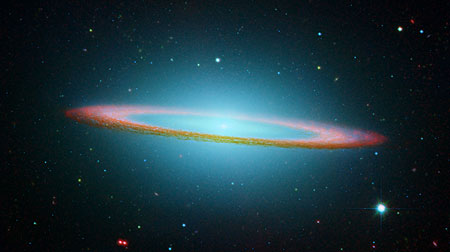 Next, the nature of galaxies is explored. Spirals, ellipticals, the
Hubble sequence and Hubble's famous tuning-fork diagram. Freeman's law, the
Tully-Fisher relation and velocity dispersion diagnostics are
highlighted. An exploration of spiral structure ensues, focusing
on the dynamics of density wave theory, which is also applicable to modeling
Saturn's rings. The course also summarizes ensemble observational
properties of ellipticals, their luminosity functions, and briefly
discusses the King profile for their matter distribution.
A combined Hubble Space Telescope/Spitzer Space Telescope image of the
Sombrero Galaxy (M104) from the Spitzer Image Gallery is depicted on the right.
Next, the nature of galaxies is explored. Spirals, ellipticals, the
Hubble sequence and Hubble's famous tuning-fork diagram. Freeman's law, the
Tully-Fisher relation and velocity dispersion diagnostics are
highlighted. An exploration of spiral structure ensues, focusing
on the dynamics of density wave theory, which is also applicable to modeling
Saturn's rings. The course also summarizes ensemble observational
properties of ellipticals, their luminosity functions, and briefly
discusses the King profile for their matter distribution.
A combined Hubble Space Telescope/Spitzer Space Telescope image of the
Sombrero Galaxy (M104) from the Spitzer Image Gallery is depicted on the right.
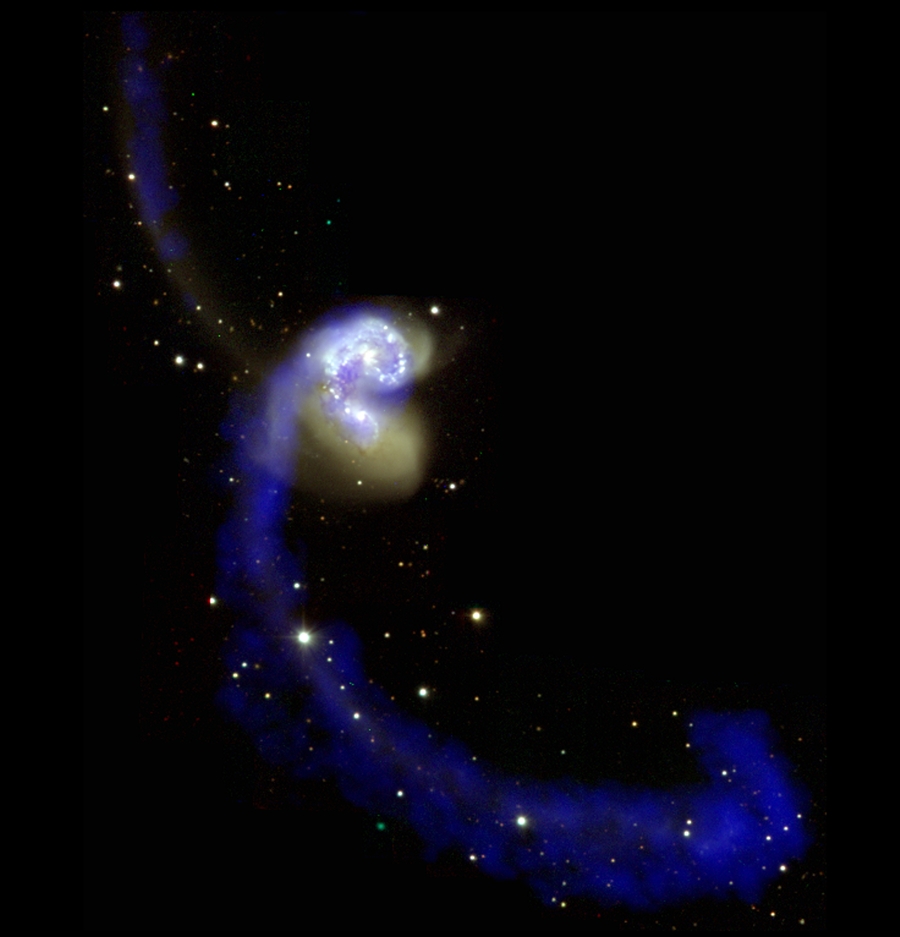 Galactic evolution and the larger scale structure of the Universe form
the next focus. A descriptive introduction to interactive galaxies is
provided, moving to key elements of galaxy formation, drawing upon
dynamical analogs with star formation from gas clouds in our own galaxy.
Determinations of the extragalactic distance scale and the critical
Hubble's law for cosmic expansion are addressed; these are essential
underpinnings for the cosmology components that were studied in the first
half of the course. This section concludes with a discussion of clusters
of galaxies and gas therein, and larger structure in the distribution of
visible matter in the universe, elucidated via various extensive and deep
sky surveys such as the classic Harvard CfA redshift one in the optical waveband.
To the right is an optical/IR montage of the Antennae galaxies NGC 4038 and
NGC 4039 in collision, highlighting stars and molecular gas (blue); it was
obtained from the NRAO Image Gallery.
Close-up images of impressive detail can be found at the
HubbleSite Image Gallery.
Galactic evolution and the larger scale structure of the Universe form
the next focus. A descriptive introduction to interactive galaxies is
provided, moving to key elements of galaxy formation, drawing upon
dynamical analogs with star formation from gas clouds in our own galaxy.
Determinations of the extragalactic distance scale and the critical
Hubble's law for cosmic expansion are addressed; these are essential
underpinnings for the cosmology components that were studied in the first
half of the course. This section concludes with a discussion of clusters
of galaxies and gas therein, and larger structure in the distribution of
visible matter in the universe, elucidated via various extensive and deep
sky surveys such as the classic Harvard CfA redshift one in the optical waveband.
To the right is an optical/IR montage of the Antennae galaxies NGC 4038 and
NGC 4039 in collision, highlighting stars and molecular gas (blue); it was
obtained from the NRAO Image Gallery.
Close-up images of impressive detail can be found at the
HubbleSite Image Gallery.
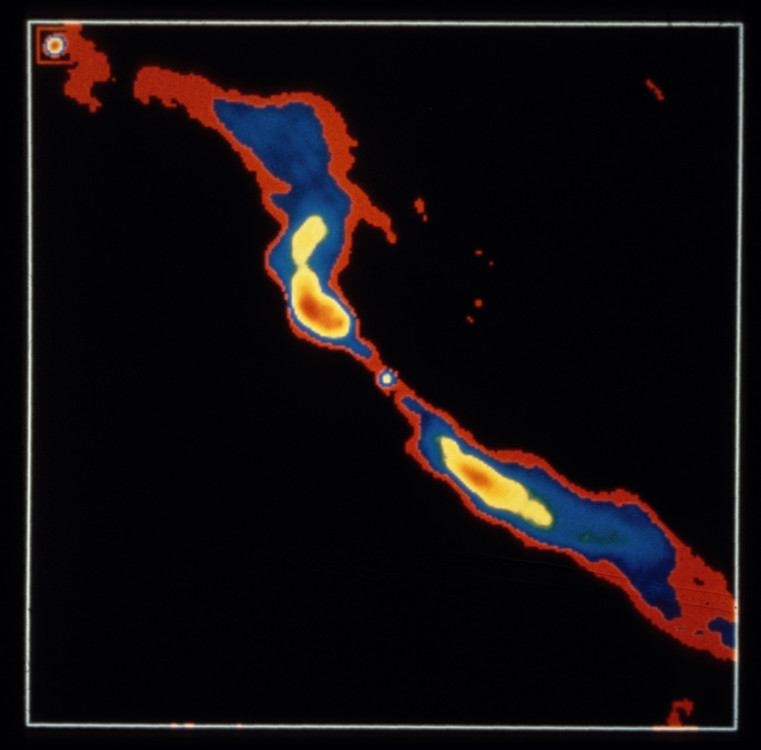 Among the most exotic and powerful sources in the universe are active galaxies.
Our studies conclude with an outline of the key features of Seyferts, radio
galaxies, BL Lac objects and blazars, and quasars, the most powerful variety
that reside at the greatest distances. Powered by disk accretion, their
central engines are supermassive black holes, whose environs are called active
galactic nuclei (AGNs). These sources often exhibit luminous, collimated jets
of relativistic gas outflow, and in the case of radio galaxies, also enormous
lobes of radio emission that signify dissipation on almost intergalactic scales.
Characteristics of the accretion disks and jets will be discussed, including
the properties of apparent superluminal motion and short timescale variability in
radio, optical, X-ray and gamma-ray bands. A brief diversion to the analogous
galactic phenomenon of microquasars will be made. The geometrical unification model
of Seyferts and blazars will be addressed, followed by an exposition on how
distant quasars can be used to probe the nature of the intergalactic medium.
A Very Large Array (VLA) image of the radio galaxy 3C 130 at 20cm
from the NRAO Image Gallery
is depicted on the left.
Among the most exotic and powerful sources in the universe are active galaxies.
Our studies conclude with an outline of the key features of Seyferts, radio
galaxies, BL Lac objects and blazars, and quasars, the most powerful variety
that reside at the greatest distances. Powered by disk accretion, their
central engines are supermassive black holes, whose environs are called active
galactic nuclei (AGNs). These sources often exhibit luminous, collimated jets
of relativistic gas outflow, and in the case of radio galaxies, also enormous
lobes of radio emission that signify dissipation on almost intergalactic scales.
Characteristics of the accretion disks and jets will be discussed, including
the properties of apparent superluminal motion and short timescale variability in
radio, optical, X-ray and gamma-ray bands. A brief diversion to the analogous
galactic phenomenon of microquasars will be made. The geometrical unification model
of Seyferts and blazars will be addressed, followed by an exposition on how
distant quasars can be used to probe the nature of the intergalactic medium.
A Very Large Array (VLA) image of the radio galaxy 3C 130 at 20cm
from the NRAO Image Gallery
is depicted on the left.

